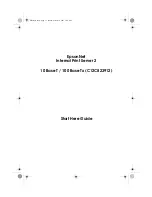
dc05cc0371
22
so the line looks like this:
Remove the hex data for the esc&l2A letter request.
Change to: DATA=
’ ‘X. /* esc&l02A */
Leaving the comment between the /* and */ helps identify the page size as letter for future reference if other
changes are made to the source file.
Workflow for Printing EBCDIC SCS and AFPDS Spool Files on Network-Attached ASCII Printer
The Host Print Transform (HPT) is the IBM program that performs the conversion from EBCDIC spool files with
SCS or AFPDS formatting, to PCL formatting and ASCII text. The HPT references the WSCST for the specific
PCL commands to use for the conversion. The WSCST is Work Station Customization Sequence Table. The
WSCST is constructed using Keywords and the Hex sequences to be used. Because the AS400 is an EBCDIC
machine, and the PCL sequences are in ASCII, the sequence characters are specified in HEX nibble format. As
an example, a PCL reset command is ESC E. The ASCII escape characters is 1B in hex. The uppercase E is hex
45. In a WSCST this would be 1B 45. At print time, the HPT will send that to the printer and it will execute the
RESET command.
The majority of the PCL commands are used
“as is” and do not need any adjustment. There are a few that need
to be adjusted for each device supported. The mapping of the DRAWER to TRAY calls is an example. The
XTOOLS library contains modified WSCSTs for most Xerox printer models. The majority of output from the
AS400 is reports and simple text pages. These were printed using line printers in the past. So, typically there are
not many different typefaces required. Courier fonts are the most common. Fonts are referenced using the
acronym FGID or GFID. (Font Global ID or Global Font ID.) The actual printer font used is defined using a
keyword and the GFID. This definition can be modified to utilize any font that is present in the printer. The PCL
sequence to select a specific font is contained in the keyword FNTSTR in the WSCST.
As an example, Global Font ID 204 is a 13.3 pitch fixed space font. It is used in printing a spool file that will not fit
on a Portrait Letter-sized media. The AS400 will rotate the page to Landscape and use the 13.3 pitch font to
squeeze the text to 11 inches.
The following line numbers refer to those in member XRXLVX in file QTXTSRC of library XTOOLS0923. It is
recommended that STRPDM or SEU be used to edit the member. It is suggested that a copy of the original
member be made with a different name. The edits can be accomplished using the standard SEU editing
commands.
The tags at line 110-115 specify that GFID 204 is to be used when rotating a spool file that has 10 pitch CPI
specified. The tags at lines 381-388 specify the PCL sequence that is sent to the printer to select the desired
font. Line 384 is the hex equivalent of the ASCII characters to be sent. Because the AS400 is natively an
EBCDIC machine, the ASCII must be in hex to coexist. At print time, the Host Print Transform will combine every
two hex characters to an ASCII character. As an example, in the member XRXLVX at line 384, the first 4
characters are 1 B 2 and 8. When combined they are actually the ASCII ESCAPE and (. So, 1B28 becomes
ESC(, the opening characters for the font selection sequence. The last 10 hex characters are 34 30 39 39 54.
When combined they are 4099T, the ending characters of the font selection sequence. Line 385 is the ASCII
equivalent of the hex sequence.
The sequence 4099T selects the Courier Typeface. To change that to LetterGothic, change it to 4102T. The hex
equivalent of 4102T is 34 31 30 32 54. W
e can either change the current characters in line 384, or “comment
out” lines 384 and 385 and enter new ones. To change the existing line 384 we would go to the end of the
sequence. The 54 at position 9 and 10 needs to stay as is, and the 34 at position 1 and 2 (of the last 10
positions) needs to stay as is. The 30 needs to change to 31, the 39 needs to change to 30 and the second 39
needs to change to 32. So, the existing 3430393954 would be 3431303254. The position numbering is exclusive
of the (FNTSTR = ‘) in the beginning and the (‘X) at the end.
To “comment out” a line, the first two characters have to be (/*), and the last 2 have to be (*/). Anything in


































